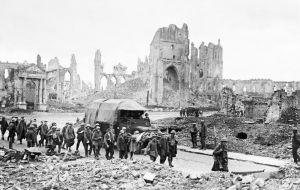MercoPress. South Atlantic News Agency
Century anniversary of the Third Battle of Ypres, remembered for the scale of casualties
 The cemetery near the Belgian village of Passchendaele is the largest Commonwealth War Grave in the world
The cemetery near the Belgian village of Passchendaele is the largest Commonwealth War Grave in the world  Passchendaele village lay barely five miles beyond the starting point of his offensive. It took over three months, leaving 325,000 Allied and 260,000 German casualties
Passchendaele village lay barely five miles beyond the starting point of his offensive. It took over three months, leaving 325,000 Allied and 260,000 German casualties  The heaviest rain for 30 years had turned the soil into a quagmire, producing thick mud that clogged up rifles and immobilized tanks.
The heaviest rain for 30 years had turned the soil into a quagmire, producing thick mud that clogged up rifles and immobilized tanks. Next 31 July 2017 will mark a century since the beginning of the Third Battle of Ypres – widely known as Passchendaele. The UK Government, in collaboration with the Belgian Government, the Commonwealth War Graves Commission, and the Royal British Legion is hosting a series of events to mark one of the defining battles of the First World War.
The full program of commemorative events includes:
30 July 2017: A traditional Last Post ceremony at dusk at the Menin Gate, Ypres, Belgium.
30 July 2017: Sunset Ceremony at the Cloth Hall, Ypres Light projections onto the Cloth Hall in the Market Square will provide the backdrop to an evening of storytelling and music about the experience of soldiers during four years of war on the Ypres Salient
31 July 2017: A ceremony at the Commonwealth War Graves Commission’s Tyne Cot Cemetery will take place on 31 July. The Chief of the Defense Staff, Joint Force Commander and heads of the Royal Navy, British Army and Royal Air Force will gather at the cemetery near the village of Passchendaele. It is the largest Commonwealth War Grave in the world.
A video which explains what happened in the grounds next to the Belgian village between July and November 1917, and the significance of the battle, has been released in advance of the anniversary.
Officially known as the Third Battle of Ypres, Passchendaele became infamous not only for the scale of casualties, but also for the mud. It lasted from 31 July to 6 November.
Ypres was the principal town within a salient (or bulge) in the British lines and the site of two previous battles: First Ypres (October-November 1914) and Second Ypres (April-May 1915). Haig had long wanted a British offensive in Flanders and, following a warning that the German blockade would soon cripple the British war effort, wanted to reach the Belgian coast to destroy the German submarine bases there. On top of this, the possibility of a Russian withdrawal from the war threatened German redeployment from the Eastern front to increase their reserve strength dramatically.
The British were further encouraged by the success of the attack on Messines Ridge on 7 June 1917. Nineteen huge mines were exploded simultaneously after they had been placed at the end of long tunnels under the German front lines. The capture of the ridge inflated Haig's confidence and preparations began. Yet the flatness of the plain made stealth impossible: as with the Somme, the Germans knew an attack was imminent and the initial bombardment served as final warning. It lasted two weeks, with 4.5 million shells fired from 3,000 guns, but again failed to destroy the heavily fortified German positions.
The infantry attack began on 31 July. Constant shelling had churned the clay soil and smashed the drainage systems. The left wing of the attack achieved its objectives but the right wing failed completely. Within a few days, the heaviest rain for 30 years had turned the soil into a quagmire, producing thick mud that clogged up rifles and immobilized tanks. It eventually became so deep that men and horses drowned in it.
On 16 August the attack was resumed, to little effect. Stalemate reigned for another month until an improvement in the weather prompted another attack on 20 September. The Battle of Menin Road Ridge, along with the Battle of Polygon Wood on 26 September and the Battle of Broodseinde on 4 October, established British possession of the ridge east of Ypres.
Further attacks in October failed to make much progress. The eventual capture of what little remained of Passchendaele village by British and Canadian forces on 6 November finally gave Haig an excuse to call off the offensive and claim success.
However, Passchendaele village lay barely five miles beyond the starting point of his offensive. Having prophesied a decisive success, it had taken over three months, 325,000 Allied and 260,000 German casualties to do little more than make the bump of the Ypres salient somewhat larger. In Haig's defense, the rationale for an offensive was clear and many agreed that the Germans could afford the casualties less than the Allies, who were being reinforced by America's entry into the war. Yet Haig's decision to continue into November remains deeply controversial and the arguments, like the battle, seem destined to go on and on.




Top Comments
Disclaimer & comment rulesCommenting for this story is now closed.
If you have a Facebook account, become a fan and comment on our Facebook Page!